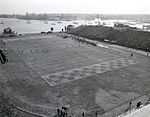Thompson Stadium
|
Thompson Stadium during the 1942 Army-Navy game | |
| Full name | Thompson Stadium |
|---|---|
| Location | Annapolis, Anne Arundel County, Maryland |
| Owner | United States Naval Academy (USNA) |
| Capacity | 12,000 |
| Field size | unknown |
| Construction | |
| Built | 1914 |
| Opened | 1914 |
| Tenants | |
| Navy Midshipmen football (NCAA) (1924–1959) | |
Coordinates: 38°58′43″N 76°28′59″W / 38.97861°N 76.48306°W
Robert Means Thompson Stadium was an american football stadium in Annapolis, Anne Arundel County, Maryland. It was constructed in 1914, and served as the home stadium to the Navy Midshipmen football team of the United States Naval Academy between 1924 and 1959. It was replaced by the larger Navy-Marine Corps Memorial Stadium. The stadium was named after Robert M. Thompson, a marine colonel and graduate of the Naval Academy. Thompson created or led several athletically based organizations at the academy until his death.
Before its conversion to a football stadium, the site of Thompson Stadium was unused area on the Naval Academy campus. Work on the stadium began in 1914, and was finished later the same year. The stadium could seat 12,000 people, and underwent few changes during its entire use. It was surrounded by a regulation running track, and only had a single seating section.
During the 1940s, the Naval Academy began to look for options to construct a new, larger football stadium. The school's directors collected money to build the stadium, which much support was given to by the public, due to the lack of seating at Thompson Stadium. Construction on the new stadium began in 1958, and the field, which would be named the Navy-Marine Corps Memorial Stadium, was completed in 1959. Use of Thompson Stadium ended that year, but the arena remained until the 1980s, when it was replaced by Lejeune Hall.[1]
Name
From its origins until the year of 1931, Thompson Stadium went without a name,[2] and was referred to on maps as simply "Football Field".[3] On May 30, 1931 the stadium was formally dedicated as the Robert Means Thompson Stadium, who was a benefactor and alumnus of the Naval Academy.[4] Thompson was born in March 1849, and graduated from the Naval Academy as part of the class of 1868. He was commissioned as an officer in the Navy in 1869, but retired two years later to pursue a career in law. After leaving the navy, Thompson became active in helping with the athletics program at the Naval Academy, donating the Thompson Cup, an award given to the academy's athlete with the greatest improvement throughout the course of the season. In addition, Thompson served as the head of several Naval Academy organisations and founded the Naval Academy Athletic Association.[5]
History
The Naval Academy's football team played their first game in 1879, an away game against the Baltimore Athletic Club. The game ended in a 0-0 tie.[6] The Navy football team, not yet known as the "midshipmen",[7] did not have an official stadium. For the duration of the 1880s, during which the squads obtained a record of thirteen wins, twelve losses, and two ties, the football squads most likely played home games on an unused drill or parade field.[2][6] From the beginning of the 1890s until 1924, a period in which the Navy squads finished with an overall record of 202-82-23, the football team used Worden Field, a large multi-use athletic field for their home games.[2][8]
References
- Footnotes
- ↑ "1972 Reef Points map". USNA Parents Club of North Texas. 9 October 2010. Retrieved 5 August 2012.
- ↑ 2.0 2.1 2.2 Kiland et al., p 191
- ↑ United States Naval Academy, Annapolis, Maryland (Map) (1924 ed.). Cartography by C.E. Miller. United States Army. Improvements to June 30, 1924. § L31-M33. Check date values in:
|date=(help) - ↑ "Navy Dedicates Stadium In Honor Of Thompson". The Sun (Baltimore, Maryland). AP. 31 May 1931.
- ↑ Royston 2009 p. 213
- ↑ 6.0 6.1 Navy 2005 p. 154
- ↑ Staff (2013). "U.S. Naval Academy Facts, Figures and History". Traditions. United States Naval Academy. Retrieved March 14, 2013.
- ↑ Navy 2005, pp. 154–157
- Bibliography
- Kiland, Taylor Baldwin; Howren, Jamie (2007). A Walk in the Yard: A Self-Guided Tour of the U.S. Naval Academy. Annapolis, MD: United States Naval Institute. ISBN 1-59114-436-1. OCLC 72799100.
- Naval Academy Athletic Association (2005). "Navy: Football History" (PDF). 2005 Navy Football. United States Naval Academy. Retrieved March 14, 2013.
- Royston, Mark W (2009). The Faces behind The Bases: Short Biographies of Those for Whom Military Bases are Named. Bloomington IN: iUniverse. ISBN 978-1-4401-3712-9. OCLC 475622904.
| ||||||||||||||||||||||||||
